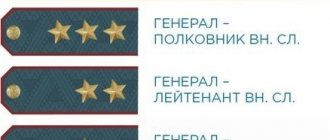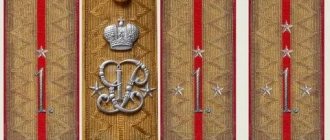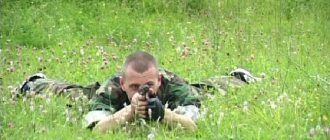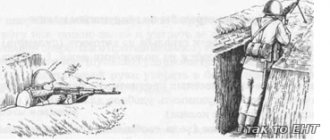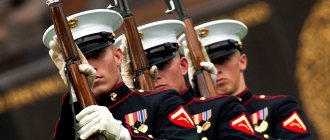What is this?
A military greeting is one of the embodiments of the comradely cohesion of military personnel of a certain state, evidence of their mutual respect for each other, a manifestation of good manners and politeness.
When overtaking or meeting, it is mandatory for military personnel to perform a military salute strictly according to the rules established by the Military Regulations of the Russian Armed Forces. At the same time, junior in rank and subordinates are the first to greet superiors and senior in rank. If military personnel are of equal ranks, then the most well-mannered one salutes first.
Which hand is used to salute?
In all countries of the modern world, military personnel salute with their right hand. In some countries there are differences in the performance of this ritual. According to the regulations, saluting in Russian troops is customary with the right hand, while all fingers must be tightly closed, the palm is turned down, and the hand itself is brought to the temple. Every person liable for military service, serving in the army or discharged from it, but wearing a uniform, must salute, observing the rules of the charter.
The honor can be given by a soldier at attention, standing, or while moving.
Thus, a citizen who puts his left hand to his temple is seriously violating the military regulations, thereby showing his illiteracy in the rules of Russian service.
Tribute
For Russian military personnel, performing a military salute is mandatory to pay respect:
- Tomb of the Unknown Soldier.
- Mass graves of military personnel who gave their lives for their homeland.
- State flag of Russia.
- The battle banner of your military unit. And also the Naval flag upon arrival/departure to the ship.
- Funeral processions, which are accompanied by military units.
Who gets the honor
To whom the military greeting should be performed is specified in the decree of the President of the Russian Federation of 2007 “On approval of general military regulations of the Armed Forces of the Russian Federation,” as well as in the Charter of the internal service of the Armed Forces of the Russian Federation.
It states that the subordinate must perform the ritual of military greeting for the senior in military rank, and, when standing, the one who considers himself more cultured and polite greets first.
In addition to military personnel, honor can be given to:
- the main war memorial of Russia, located near the Kremlin walls - the Tomb of the Unknown Soldier;
- mass graves of soldiers, so-called group graves of soldiers who died presumably at the same time, who died fighting for the freedom and independence of their homeland;
- the official symbol of the state - the flag of the Russian Federation, the Battle Banner of the military unit - the main symbol and relic of the military unit, indicating affiliation with the Russian army, the Naval flag at each arrival or departure of the ship;
- during funerals that take place with the participation of military units.
Also, when in formation, military groups and units must salute at the command “at attention” to the current President of the Russian Federation, the Minister of Defense, the Chairman of the Government of the Russian Federation, marshals, generals, admirals, as well as other persons who were appointed as leaders or arrived to present the Combat banner
Military units and units must perform a military salute to each other.
In service
When in formation, performing a military salute is mandatory for units and subunits in the following cases:
- Greetings from the President of the Russian Federation.
- Greetings from the marshals of the Russian Federation, army generals, colonel generals and admirals and admirals of the fleet.
- Greetings from all direct superiors, as well as persons appointed to manage checks (inspections) of this military unit.
- Greetings to persons who came to the military unit to present the Battle Banner and/or state awards.
How is the military salutation performed in the ranks in front of the indicated persons? The following algorithm is followed:
- The senior-ranking soldier says the following: “Attention! Alignment to the right (to the middle, to the left)!
- Next, he meets the above-mentioned persons and reports to them (for example): “Comrade Colonel General, the 50th Tank Regiment has been built for the regimental general verification. The regiment commander is Colonel Ivanov.”
If a military unit is being built with the State Flag or Battle Banner (cadet review, parade, swearing-in), then the report must mention the full name of the military unit (military unit), as well as list the orders and honorary awards awarded to it.
Military salute
Even those people who are very far from the army and military service and have nothing to do with it are well aware of the ritual of military greeting. In the language of encyclopedias, a military salute is a greeting from military personnel or armed forces of different countries, established in accordance with governing documents. The military salute is referred to as military rituals, traditions or military etiquette. Previously, the military salute was also called a salute, a salute, a salute, and it can also be designated by the word “trump.” At the same time, there are a sufficient number of hypotheses for the origin of this army ritual. According to one version, the military greeting came to us from the Middle Ages, being a knightly tradition. When meeting with each other, the knights raised the visor of their helmets with a movement of their hands to show that their friend’s face was hidden under it (this version does not take into account the fact that all the knights had their own coats of arms on their shields, clothes, flags, this was enough to the friend managed to identify the friend). According to another version, by raising the visor of their helmet, they demonstrated their peaceful intention. This was done with the right hand to show that the knight was not yet ready to start the battle and did not have aggressive intentions. Such a gesture seemed to indicate that “there is no weapon in my right hand now.” At the same time, among peoples who were deprived of heavily armed cavalry (Mongols, Indians who inhabited North America), the greeting salute consisted of a simple demonstration of an open right hand. The most romantic version of the appearance of the military greeting is also attributed to the era of chivalry. With this gesture, the knight at the tournament closed his eyes, protecting himself from the dazzling beauty of the beautiful lady of his heart, who was watching his performance.
But, most likely, the military greeting in the form in which we know it today appeared in Great Britain. The version that such a greeting originated in the British Isles in the 18th century is documented by military regulations. In those years, in many armies of the world, junior military ranks, when greeting their senior ranks, took off their hat or other headdress. This was the case in the UK, but over time, headgear, especially in elite units, became very bulky, so that the salute was reduced to the usual raising of the hand to the headgear and touching the visor. The greeting known to us all first took shape in 1745 in the regiment of the Coldstream Guards, an elite unit of the Queen of England’s personal guard. At the same time, the military’s equipment was constantly changing, and the gesture was slightly transformed.
Over time, even the very touch of the headdress with the hand disappeared. According to one version, replacing the removal of headdresses with simply raising your hand to them may be associated not just with heavy and bulky headdresses, but also with the widespread use of firearms. The first samples of small arms could hardly be called perfect. The soldiers' hands were almost always stained with soot, since they had to set fire to the oppressive muskets, and their hands also got dirty when reloading small arms. Thus, dirty hands covered in soot could cause damage to the headdress when trying to remove it for greeting.
Military salute in Great Britain
At the same time, in the military greeting of any army in the world, they do not lower their eyes or bow their heads, which speaks of mutual honor, regardless of rank, rank or rank. There is also no question of which hand is used to salute in the army. Always right. At the same time, the hand gesture itself and the turn of the palm may differ slightly in different countries of the world. For example, starting from the 19th century, in the British Army, the hand raised to the right eyebrow was facing outward with the palm. This greeting has been preserved in the army and air force, at the same time in the royal navy since the days of sailing ships, when the hands of sailors were stained with tar and tar, and showing dirty palms was undignified; during a military salute, the palm was turned down. Exactly the same greeting was accepted in France. In the American army, the greeting could have been taken from the English navy. At the same time, in the USA, during a military salute, the palm is turned down, and the hand, which is moved slightly forward, seems to shield the eyes from the sun. In the Italian army, the palm is placed above the visor in front.
For many, it may be a revelation that in the German army during the Second World War, soldiers and officers did not “zig” right and left, as can often be seen in feature films. Throughout almost the entire war, Wehrmacht units adopted a standard military salute with the right hand raised to the head, which was prescribed in the regulations. The introduction of the party or Nazi salute in the Wehrmacht occurred only on July 24, 1944, immediately after the unsuccessful assassination attempt on Adolf Hitler, which was organized by officers.
In the Russian Empire, until 1856, the military salute was not performed with the entire palm, but only with the index and middle fingers. To this day, this greeting has been preserved in the Polish armed forces. Since 1856, after the end of the Crimean War, in the army of Tsarist Russia, and then the Soviet Army and the modern Russian army, the military salute is given with the entire palm. The middle finger looks at the temple, lightly touching the visor of the uniform cap. This, by the way, is where the synonyms for giving a military honor or a military salute arose - to take one’s salute, to raise one’s salute, etc.
Currently, the rules of military salutation in the Russian Federation are also mandatory for persons who have already been discharged from military service when they wear military uniforms. In the Russian Armed Forces, the military salute is performed with the fingers of the right hand closed and the hand straightened. Unlike the armies of some other states, with the head uncovered, the military salute in the Russian army is performed without raising a hand by means of the serviceman taking the line position.
Military salute in Poland
When moving in formation, the military greeting is carried out as follows: the guide puts his hand to the headdress, and the formation presses his hands at the seams. All together they take a marching step and turn their heads as they pass by the commanding officers they meet. When passing towards units or other military personnel, it is enough for the guide to perform the military salute. At the same time, in the Russian army, when meeting, a junior in rank is obliged to greet the senior in rank first, and a senior in rank may perceive failure to perform a military greeting during a meeting as an insult. If the serviceman is not wearing a headdress, the greeting is performed by turning the head and assuming a combat position (the body is straightened, arms at the sides).
But not in all countries the military salute to senior ranks is the duty of a serviceman. For example, in modern units of the Israel Defense Forces, the procedure of saluting upon seeing a senior in rank is mandatory only during the course of a young soldier. In all other cases, the military salute is not an obligation, but is the right of the serviceman. In parallel with this, prisoners in Israeli military prisons (an analogue of the domestic guardhouse) are completely deprived of this right.
Military salute in Russia
In all countries, the military salute is given exclusively with the right hand. The question of which country salutes with the left hand usually arises when high-ranking government officials, due to inexperience or oversight, violate the rules of military salutation, which are either an unshakable tradition or enshrined in regulations. A serious difference in a military salutation is not what hand is used to salute, but only the presence or, conversely, the absence of a headdress on the soldier during this military ritual.
The well-known expression today “you don’t put your hand to an empty head” in Russia is usually remembered in the same context with the tradition of military greetings in the United States. In the American army, it is not mandatory for a soldier to wear a headdress when raising his hand to his head. Historians justify this difference as follows. During the Civil War between the North and South (1861-1865), the northerners won. History, as we know, is written by the winners, who form certain traditions. Unlike the Southern army, the Union army that won the war was composed primarily of volunteers. Many of these volunteers, especially early in the war, wore civilian clothing. From this we can conclude that the rank and file of the northern army sometimes had no headdresses at all - hence the tradition of a military greeting, regardless of whether the soldier had a headdress on or not.
Military salute in the USA
At the same time, the military greeting, which looks natural in peacetime, fades into the background or even further during hostilities. In many conflicts of the 20th century, statutory conventions and military chain of command posed a threat to the lives of senior officers. In popular culture, this is well reflected in the American films Saving Private Ryan and Forrest Gump, in which there are episodes where soldiers receive a beating from more experienced comrades for giving the military salute to their commanders. During combat, this helps enemy shooters and snipers determine their priority target.
Sources of information: https://masterok.livejournal.com/1456518.html https://fb.ru/article/217526/voinskoe-privetstvie-ili-kakoy-rukoy-otdayut-chest#image1022221 https://warspot.ru /1448-voinskoe-privetstvie Materials from open sources
In move
Performing a military salute on the move is necessary when military units meet each other. It is also performed to pay tribute to:
- Tomb of the Unknown Soldier.
- Mass graves of military personnel who gave their lives for the Fatherland.
- State Russian flag.
- The battle banner of your own military unit.
- The naval flag on a ship during its lowering and ascent.
- Funeral processions accompanied by military units.
In ranks on the spot
Now about performing a military greeting in the ranks on the spot. It is necessary in the following cases:
- Greetings from the President of the Russian Federation.
- Greetings from the Chairman of the Russian Government.
- Greetings from the Minister of Defense.
When performing a military salute on the spot, the orchestra performs the Russian State Anthem, as well as the composition “Counter March”.
If a military unit greets its direct superior, as well as persons sent to inspect this military unit, who have arrived to present a state award or combat knowledge, then the musicians play only the “Counter March”.
Out of formation
We continue to analyze the military greeting and the order of its implementation. When out of formation (for example, during assignments or in free time from this activity), military personnel greet their direct superiors with “Attention” or “Stand at attention.”
Only direct leadership, as well as persons assigned to inspect the unit, will be welcomed at headquarters.
At meetings and training outside the formation, where only officers are present, “Comrade officers” is used to greet commanders.
“At attention”, “Comrade officers”, “Stand at attention” is said by the eldest of the commanders present or the one of the military personnel who first saw the superior commander.
Further instructions imply the following:
- At this command, all those present must stand up and turn towards the arriving chief, commander.
- The military personnel take a stance. If you have a headdress, raise your right hand towards it.
- The eldest of all those present must approach the commander and voice a report.
- Having accepted the report, the commander (soldier-chief) gives one of two commands: “Comrade officers” or “At ease.”
- The soldier who presented the report must repeat this command to everyone present.
- Next, the military personnel take the command “At ease.” The hand is removed from the headdress.
- The military personnel then act on the command of the arriving commander.
Special cases
Let us also consider special cases characteristic of the Russian army:
- Commands “Stand up. Attention" and "Attention", as well as a report to the chief or commander, are announced upon his first visit to a certain military unit or unit.
- “Attention” is given to the commander of a warship each time he arrives on the ship, as well as leaves it.
- In the presence of a senior officer, commands for military greetings are not given to the junior commander. In this case, a report to him is also not made.
- In the case of conducting all kinds of classes: “Attention”, “Comrade officers”, “Stand up. Attention” are spoken at the beginning and at the end of these classes.
- Commands “Stand up. Attention”, “Comrade officers”, “Attention” before reporting to a senior serviceman or commander are given only in one case - when other servicemen are present. If there is only one speaker, he simply voices the report to the commander.
- Performing a military greeting without a weapon on the spot is not necessary when holding conferences, ceremonial events in a military unit, as well as when the unit attends concerts, performances, and cultural events.
- When a superior or senior in rank addresses other military personnel, the following is observed: they (the exception here is only those who are sick or wounded) do a drill. They pronounce their position, as well as their rank and surname.
- When shaking hands, the senior person shakes hands first. If he is wearing gloves, he first removes this accessory from his right hand. Military personnel without a cap or hat must accompany the greeting with a bow of the head.
- To the greeting of the commander, senior in rank, “Hello comrades,” all military personnel (both in and out of the ranks) are required to respond: “We wish you good health.” “Comrade” and the rank of commander are added (without prefixes such as “justice”, “medical service”).
- If the commander, the senior in rank, says goodbye (“Goodbye, comrades”), then all the military personnel present answer him “Goodbye.” “Comrade” + title without prefixes is also added.
- If the commander thanks or congratulates a serviceman in the order of service, then the latter replies “I serve Russia.”
- If the commander congratulates a military unit in formation, it responds with a three-time drawn-out “Hurray.” If he thanks the military personnel, then they respond, “We serve Russia.”
The command is not given
Performing a military salute in formation, on the move, or outside formation is not always carried out. There are several cases when it is not required:
- When a military unit is alerted, on marches, during exercises and various tactical exercises.
- At communication centers, control points, and in places of combat duty (or duty).
- At the starting firing position, at the firing line during launches, as well as firing.
- During flights at military airfields.
- In continuation of work and classes in hangars, workshops, parks, laboratories. And also when performing similar work for educational purposes.
- During games and sports.
- When military personnel eat food.
- After the “End” command and before the “Rise” command.
- In rooms for patients.
Performing a military salute without a weapon is not necessary here. In these cases, the following occurs: the senior soldier reports to the arriving superior. For example: “Comrade Major! The third motorized rifle unit performs its first shooting exercise. Unit commander Petrov."
If the unit is involved in a funeral procession, it also does not perform the greeting.
The military salute is a special ritual observed for important occasions. It has its own characteristics in different situations. There are cases when his work is not required.
When is a greeting optional?
Many argue that a military salute is raising the right hand to the temple, so they do not consider the following situations to be a salutation:
- during the march of a holiday, for example, on May 9 at a parade;
- during a funeral procession;
- if you have a weapon in your hands;
- if there is no headdress;
- if the soldier's hands are occupied with a burden.
In reality, as was said earlier, in these cases the hand is not really raised to the temple, but honor must still be given, but in a slightly different way: in a straight combat stance and turning the head towards the soldier.
Situations where it is really not necessary to greet another military man:
- at the place of combat service, during firing, while in a firing position;
- when units cannot disperse, for example, on stairs or ravines;
- during parades, when a soldier is in a car without windows and open hatches or in the cabin of a car;
- the military men driving the car do not salute;
- honor guard sentries and flag bearers;
- during household and sports work.
